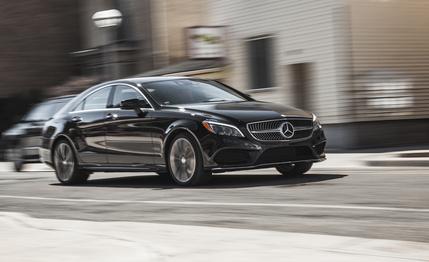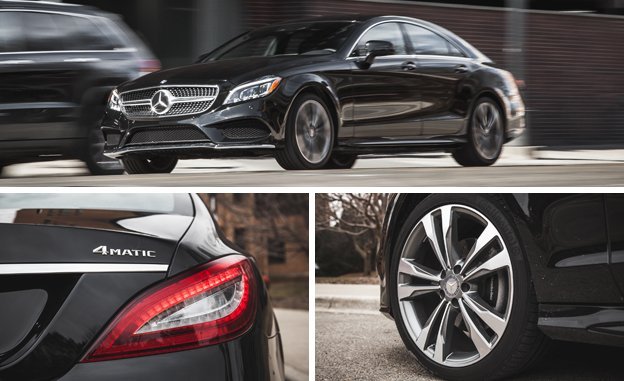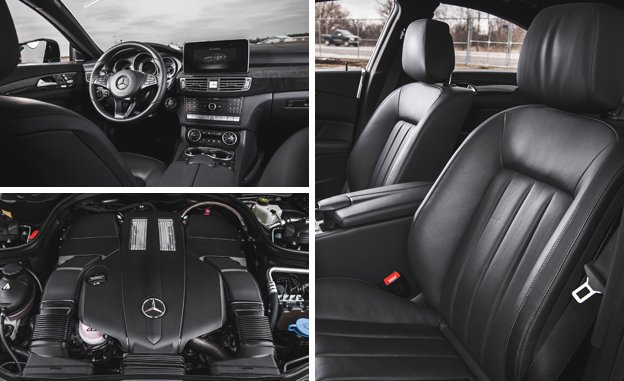
 Instrumented Test
Instrumented Test
Mercedes-Benz gets credit—or blame—for inventing the whole silly “four-door coupe” thing with the CLS550 it launched in the U.S. in 2005. It took Audi and BMW a while to catch on, but today the notion of a sleeker but less functional four-door is so common that it has even spreaded to, heaven help us, the SUV segment. So it probably irritated the three-pointed-star team no end to see the second-generation CLS finish behind the less expensive and less powerful Audi A7 in a comparison test shortly after the new Benz arrived.
Back then, the CLS550 was the entry model—its turbo V-8 gave it a clear straight-line performance advantage over Audi’s supercharged V-6, but it lost far more points by being extraordinarily expensive, too cramped, and thirsty for fuel.
For 2015, M-B added a model at the lower end of the range, the CLS400. Using a twin-turbo V-6 in place of the V-8, it’s aimed more squarely at the Audi (and BMW’s six-cylinder 640i Gran Coupe) with a lower price, less power, and improved fuel efficiency compared with the CLS550. Sharing facelifted bodywork and a revamped interior with other 2015s, the CLS400 employs the familiar seven-speed automatic just as the 550 embraces a new nine-speed. Making Audi allusions even easier, this example showed up with 4MATIC all-wheel drive.
As you’d expect, a 3.0-liter turbo six doesn’t accelerate—or sound—like the forced-induction V-8. At the track, this example hit 60 mph from a standstill in 5.1 seconds, nearly a second slower than that comparison-test CLS550 but, crucially, equal to the Audi in that matchup. Ingolstadt hasn’t been standing still, though, and we’ve already driven the 2016 A7 rated at 330 horsepower, up by 20 ponies over last year’s model.


At 4264 pounds, this 4MATIC car was 100 pounds heavier than the older comparison-test-losing V-8 model, which was rear-drive. Nevertheless, handling and braking improved significantly. Optional air suspension ($1610) and 19-inch wheels ($500) wearing Continental summer performance tires are all similar, but we saw a 0.94-g rating on our skidpad, a gain of 0.05 g over the rear-drive model. Stopping from 70 mph took 153 feet, fully 10 shorter.
We also got 20 mpg during our test, just beating the EPA city rating, although the buyers of pricey luxury cars may not care much given the current environment of low fuel costs. All these numbers would have made the Mercedes look much better against the Audi we tested it against in 2011, so we’re eager to get a 2016 A7 to the track and see how it measures up.
If this CLS runs much like its Audi counterpart, its pricing is also more competitive. The 4MATIC’s base figure comes within shouting distance of $70,000. Option inflation on this one starts with a 10-percent bump ($6900) for the Premium 2 package. That’s basically COMAND with its panoply of navigation, telematics, voice controls, and so forth, plus keyless start, ventilated front seats, Adaptive Highbeam Assist, and LED headlamps with Active Curve Illumination, power-folding mirrors, and on and on. Another $2800 brings the Driver Assistance Package, the array of lane-keeping, collision-warning, blind-spot assist, etc. safety technologies featured in that TV commercial for the E-class—you know, the one with the “crash test,” where the car doesn’t crash? You might expect that package to include the Parking Assist with surround-view camera, but that’s another $1290. There was also $1370 worth of black leather, $440 for a split-folding rear seat, and another $625 to heat the rear seats. The “Active Multicontour” driver’s seat was totally worth $660, but it ought to be standard.


We found the CLS most enjoyable to drive if we took the time, before leaving the driveway, to deactivate most of the assists, so we’d probably be better off not checking that option box at all. As with the E-class with which it shares a platform, the CLS’s “Intelligent Drive” technology takes a big step into the autonomous-car future. These technologies are allegedly among the options most desired by new-car shoppers. In rush-hour highway conditions, they can ease worries and people seem eager to have the backup just in case, you know, they get distracted by a text message or a cat video.
This comes at a price we’d just as soon avoid—and not just the monetary one. Technology that thinks on your behalf has to assume you’re not thinking for yourself. This car was sounding alarms, braking, and even steering us away from “imminent” collisions with large signs or piles of snow at the curb when, in fact, the road curved away from these obstacles. Presumably, the technology that works so well on major highways couldn’t read the road properly because the lines were obscured or nonexistent on our local streets. Once, seeking to avoid a badly patched, pothole-strewn stretch of pavement on a two-lane artery, we moved into the other lane. The asphalt was much smoother over there, we could see more than a mile ahead on this sunny day, and there were no oncoming cars, but simply crossing the double-yellow line freaked the CLS right out. It applied the brakes without our bidding, bringing us from 35 mph to 10 mph in short order, perhaps reading roadside objects (snow piles, trash cans, signs) as vehicles. All the warnings and alarms made us feel like Kimi “Just leave me alone, I know what I’m doing” Räikkönen. We liked the car well enough, but it didn’t always seem to like us. We won’t say consumers shouldn’t want this stuff—only that they should know what they’re buying . . . and how and when to disengage it.
A decade ago, when the CLS first brought the four-door coupe into being, it was a sleek and elegant alternative to the more stately E-class sedan and wagon. It was pricey, but distinct enough to justify the expense. Today, there’s an actual two-door E-class coupe and even the regular sedan wears fairly stylish lines. The premium price for the CLS’s mildly more appealing design, outside and in, might be harder to justify all on its own, then. Yet this new, less costly V-6 model amends the value proposition, bringing sufficient performance at a starting price that lets the customer add on “all the toys” or just select the ones that appeal most. It can even be fun to drive, if you take a moment to let the car know who’s the boss.